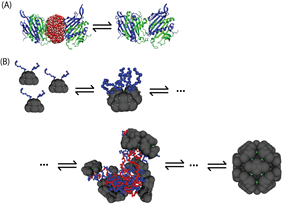Research
Our group uses modern computational techniques to solve important problems in biology and soft condensed matter physics. The goal is to uncover the physical principles that govern assembly of cellular machines and dynamic pattern formation in living and non-living systems.
As an example of this approach, consider the life cycle of a typical virus. After infection, hundreds of protein subunits assemble around the viral nucleic acid to form a protein shell, or capsid. The capsid then targets another cell and, once inside it, partially or completely disassembles to deliver its infectious nucleic acid cargo. Learning the principles that make viral assembly and disassembly so robust would enable the rational design of antiviral drugs that block those processes. Furthermore, learning to mimic the capabilities of viruses could spur the design of gene therapy or drug delivery devices that assemble, target, and then disassemble to deliver their cargo without external control.
Our research program can be broken into four related areas:
- The first area is focused on determining the mechanisms by which viral capsids assemble and the factors that control the robustness or fragility of this process.
- The second area examines the effect of chirality and particle anisotropy on assembly pathways of filamentous molecules or rod-like colloids, with a particular focus on mechanisms by which assembly can be designed to self-terminate in one or more dimensions.
- The third area also studies systems of filamentous molecules, but explores the emergent patterns and dynamics that arise when the filaments are made active by the introduction of molecular motors.
- Finally, the fourth area uses computation to reveal the molecular structures along conformational transition pathways in signaling proteins and enzymes, applying the same methodologies that we use to simulate conformational transitions in viral proteins.
Characterizing mechanisms of assembly processes or conformational interconversions is challenging because intermediate structures are transient and thus not experimentally accessible. Simulations can overcome this limitation, but are computationally prohibitive when structures or patterns are orders of magnitude larger than their individual components. Therefore, our approach is to bridge length scales, from Angstroms to hundreds of nanometers, by using atomic-resolution simulations to develop tractable coarse-grained models that retain the relevant molecular properties. Since experimental data is essential for developing and validating models, we collaborate with groups who perform experiments that span these scales by simultaneously monitoring microscopic components and large-scale structures and kinetics.
